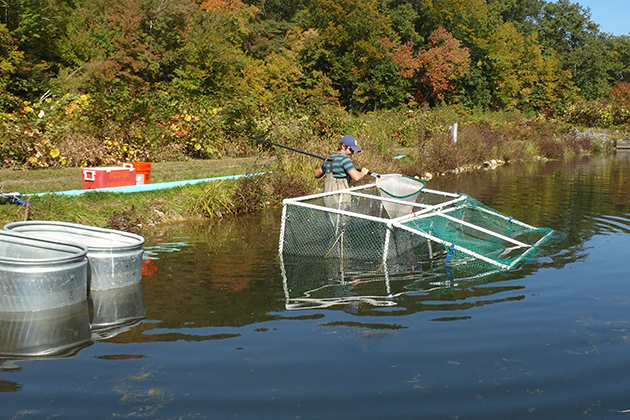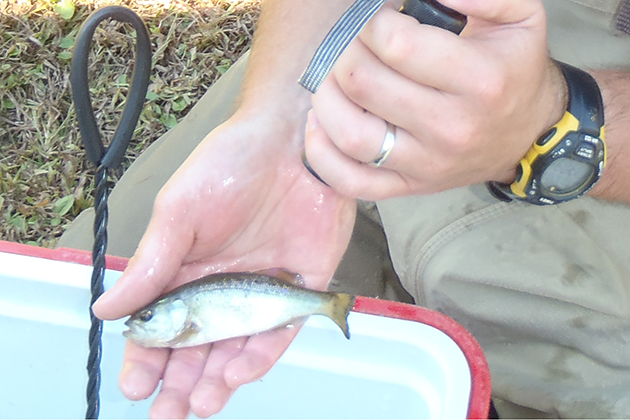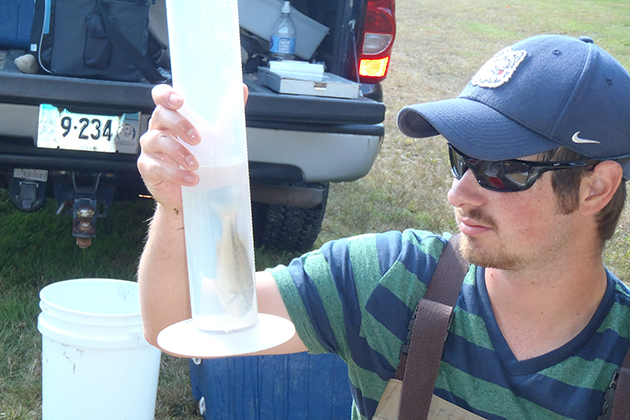
The most aggressive largemouth bass in the lake are also the ones most prized by anglers. These are the fish that literally ‘take the bait’ and put the fun into both competitive and casual sport fishing.
Then, most fish are unhooked and tossed back to swim away without any lasting consequences. But a new UConn study says that recreational fishing has an impact, and the evolutionary path of a species may be on the line.
In a recent paper published in the journal PLOS ONE, a team of researchers led by Jan-Michael Hessenauer and Jason Vokoun of the Department of Natural Resources and the Environment, found that recreational fishing appears to influence which types of fish are the species’ fittest.
“This scenario genetically favors the fish with lower metabolisms, the fish that are less likely to be caught by anglers,” Vokoun says. “It suggests that we may be permanently changing exploited fish populations over the long term.”
The potential for recreational fishing to act as an evolutionary force is well established in theory. But this is the first study to identify outcomes of selection from recreational fishing of wild populations using unfished populations as a reference.

Researchers compared populations of largemouth bass in two lakes that are open to recreational fishing and two that have been undisturbed for hundreds of years. Connecticut has significant wild populations of largemouth bass living in protected bodies of water due to stringent management practices enforced by local water companies.
The researchers collected baby fish from the fished and unfished lakes and transferred them to a protected location with no anglers and no predation from larger fish. Prior to being released into the pens, each fish was tagged so it could later be identified by its place of origin.
Despite their different origins, the two populations grew up in the same environment and experienced the same rearing conditions. After one year, the researchers measured the fishes’ resting metabolism.
They found that a significantly higher number of fish taken from the lakes where fishing was allowed had lower metabolic rates compared with the fish taken from protected bodies of water.
We may be permanently changing fish populations over the long term. — Professor Jason Vokoun
“The results point to a reduction in the type of behavior that is so prized by anglers,” says Hessenauer, a doctoral student.
Several factors may be influencing this, according to Vokoun, associate professor of natural resources and the environment and director of UConn’s Wildlife & Fisheries Conservation Center. Male largemouth bass are aggressive nest guarders, and if they are removed permanently, the nest will likely fail.
More aggressive females that are caught and released may suffer physiological stress that results in egg resorption and the production of fewer offspring, he says. If the same fish are caught more than once, their energy levels may be depleted, and typical behavior altered.

The next step in the research will be to breed fish that come from protected areas with those that come from unprotected areas, with the hope that the offspring will inherit some of the vigor and persistence of their wild kin.
The current findings may have implications for fish management practices, says one of the study’s co-authors, Robert Jacobs, Eastern District supervisor for the Inland Fisheries Division of the Connecticut Department of Energy and Environmental Protection (DEEP), which funded the study.
“People affect the genetics of plant and animal populations just by the way we interact with them, and this study contributes to a body of knowledge that will help us truly understand how traditional management strategies may become less relevant over time,” he says. “The findings in this study may be a strong signal that we need to be much more creative in the ways we manage our inland fisheries.”



